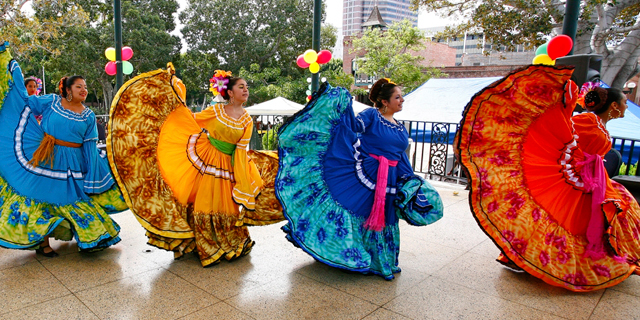Here’s a question: What is the reason we in the United States
celebrate Cinco de Mayo? If your answer
is to celebrate Mexican Independence Day, you’d be wrong. Mexican Independence Day is actually
September 16th and Cinco de Mayo
is the holiday that commemorates the Battle of Puebla, which took place in 1862
in the Mexican state for which it’s named. On the 5th of May,
Mexican forces defeated French forces in an unlikely victory.
So, we ask again, why do we
celebrate Cinco de Mayo in the United States?
“There is usually some confusion
between Mexican Independence Day and Cinco de Mayo,” says John Kopczynski, public relations director for El Pueblo de Los Angeles, a public plaza
and cultural center in the middle of the buzzing bustle of downtown LA. Kopczynski adds, “[That] victory is really about
overcoming obstacles against all odds.” A day that fills many Mexicans with pride, we couldn’t think of a better reason to raise our salted rims and
drink margaritas guilt-free on a Monday.
This year, in addition to the
traditional and ubiquitous Cinco de Mayo festivities such as mariachis and folklorico dancing, ice-cold margaritas
and delicious eats, El Pueblo will also have an interactive history component
to better educate the masses about the true meaning of the day. This is what El
Pueblo does best – act as a conduit between the LA of present and its Latin
roots.
Rusty on your Los Angeles history?
You are not alone. The City of Angels
was founded 233 years ago, on September 4, 1781, when 44 Mexican settlers – 11
husbands, 11 wives and a smattering of kids, all of mixed ethnic backgrounds –
traveled up from San Diego, set up an outpost under the Spanish flag on El Rio de la Porciuncula, now known as
the Los Angeles River.
Today, after two wars, two flag
changes (first to Mexican, then to American), 19 freeways, eight major highways, three interstate highways, and countless earthquakes later, the City of Los Angeles
has a population of 3.85 million people, half of them Latino. The present-day
El Pueblo de Los Angeles, now a 44-acre park protected by Congress, acts as a
window into not just the city’s Latin heritage, but also into many of the other
ethnicities that have fused with Latinos to build up LA into California’s mega-tropolis.
A trapezoidal partition of downtown
LA that borders other well-known sites such as City Hall, Chinatown, Union
Station and Little Tokyo, El Pueblo also houses the city’s oldest cemetery (Campo Santo), house (Avila Adobe) and
Catholic church (La Iglesia de Nuestra
Señora la Reina de Los Angeles).
Next, how Cinco de Mayo is celebrated today… [pagebreak]
At the center of El Pueblo you’ll
find the Plaza, the crux of town life, in its heyday, now beautifully
landscaped and well-preserved. A weekly rotation of musicians
plays under the watchful eye of LA’s sun. This is also where most of
the festivities take place on Cinco de Mayo. Dotting the Plaza, you’ll find
murals by Mexican muralist David Alfaro Siqueiros and Italian-American muralist
Leo Politi. In addition to Mexican and Los
Angeleno tributes, you’ll find homages to Chinese and Italian influences with
the Chinese American Museum and the Italian American Museum, where many locally
and internationally renowned artists are on display.
Perhaps the most colorful way to
pass your time at El Pueblo is to stroll down Olvera Street, a lively Hispanic
marketplace lined with informal taquerias and slightly more formal sit down
venues. Named after Judge Agustín Olvera, the early 20th century saw
this quaint alleyway fall into disrepair, and Avila Adobe was set for
condemnation. But in 1928, a young woman named Christine Sterling strolled by
the historic place. “Forsaken and forgotten” Ms. Sterling would later write in
her diary, with “filth everywhere”. Appalled by its disrepair, she began to
petition to restore the Avila Adobe to its
prior glory and install a Mexican-themed marketplace right outside. She even went
so far as to host a barbeque in the open-air patio of the house, where tequila
was served despite Prohibition laws at the time. She raised over $10,000 for
the project, and Police Chief James “Two-Gun” Davis even agreed to supply the labor in the form of
jailed inmates.
Today, more than two million people
visit El Pueblo de Los Angeles every year, whether to nosh on world-famous
taquitos in guacamole sauce from Cielito Lindo, one of the
oldest restaurants on Olvera Street, or to pick up Mexican crafts, tour
one of its stellar museums or attend one of its cultural events such as Cinco
de Mayo. Says Kopczynski, “All cities
need to have that special public space, a universal destination where visitors
and locals alike can explore and experience its multicultural past and present,
knowing that they too have a part in a shared living history.”
To visit El Pueblo de Los Angeles,
or to check out their roster of events, click here.


![Making Mealtime Matter with La Familia: Easy Sofrito [Video]](https://thelatinkitchen.com/wp-content/uploads/2015/10/sofrito-shutterstock__0-500x383.jpg)
![Easy Latin Smoothies: Goji Berry Smoothie [Video]](https://thelatinkitchen.com/wp-content/uploads/2015/12/goji_berry-shutterstock_-500x383.jpg)
















![Fun and Fast Recipes: Fiesta Cabbage Salad [Video]](https://thelatinkitchen.com/wp-content/uploads/2015/11/fiesta_cabbage_slaw-shutterstock_-500x383.jpg)









